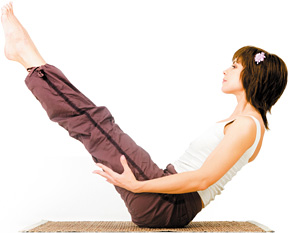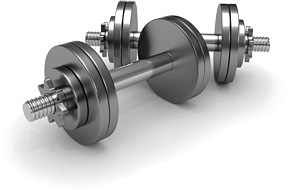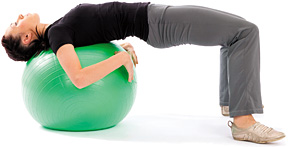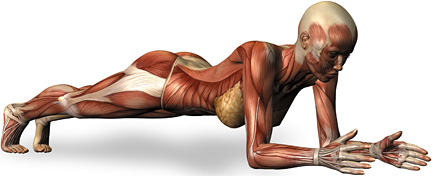Has your workout program been in a downward spiral lately? Have you been doing less and less physical activity? Are the once pain-free activities now causing increased pain? If so, you might want to resume your workouts with isometricexercise.
You are probably more familiar with isometric exercises than you think. If you play sports or do any movement that involves changing directions, that in-between change-of-direction time, no matter how brief, requires an isometric contraction. If you are familiar with doing biceps curls with a dumbbell, each time you hold the weight at the top or the bottom of the movement, you are performing an isometric contraction. You change from one muscle contraction type to the other, but the “hold” portion of the exercise is an isometric contraction. The fun thing about isometrics is that you can hold the contraction for only 5-6 seconds or you may hold it for 30 seconds, a minute, 2 minutes, etc. The length of the “hold” plays a very important role in strengthening.
Isometric contractions help improve body awareness, posture, movement and strength. Isometrics produce muscle contractions, but you are not moving an arm or a leg or the trunk while performing isometrics. It’s a static “hold it” position. You can make the sensation of the contraction effort really hard, hard, or a little hard. Holding a yoga pose is a good example of a static “hold it” position. Your own body-weight acts as the resistance.

Just lean against a wall with both hands, push against the wall and you will cause an isometric contraction in the arms and torso. When you press the palms of your hands together in front of your body, you will feel the muscle tension in the chest. Lifting a heavy object or free weight (dumbbell), or holding the weight stack in a machine at a certain level or height, will cause an isometric contraction.
In my chiropractic practice, I like using isometric exercises for improving posture and developing initial strength. If you are just beginning a workout program, coming off an injury, or can’t make it to the gym where weights or weight machines are available, doing isometrics will provide some progress in your training. If you feel muscle weakness or have had the experience of getting injured when you start to work out, and/or you get easily injured when working out, isometrics can help prevent injury.
Gaining Strength in All The Right Places
Have you ever watched someone have a hard time standing up and getting out of certain chairs or couches? This suggests a need to strengthen the legs (quadriceps) and stabilize balance. If I see a person having difficulty getting out of a chair, using the arms to climb up, then gaining strength back in the legs is a priority. To perform a “get up out of a chair,” your legs produce most of the force. The momentum must be transferred through a stable trunk to the upper body.
You can perform an isometric exercise to strengthen the legs by duplicating the position of getting out of a chair. To do this, stand against a wall with your feet facing straight ahead. Your hips, upper back and head should be up against the wall. Walk your feet away from the wall approximately 2 to 2 ¼ feet. Bend your knees and start sliding down the wall. Hold this position and keep the weight in your heels. Your lower back should be flush up against the wall. Build up to holding this position for 2 minutes. Holding positions at the angles / stages at which you have the greatest difficulty getting up can help you overcome those sticking points and improve your ability to transition from sitting in a chair to standing up.
No matter your age or level of fitness, certain muscles should constantly be worked. For example, no one wants flabby butt muscles. A simple isometric contraction for flabby butt muscles (gluteals) is the gluteal squeeze. Stand with your feet pointed straight ahead and begin squeezing your buttocks together. Hold for 6 seconds and then release your buttock muscles. Repeat this for 20 repetitions and build up to three sets. Try to relax your upper body, your stomach and your thighs while performing the gluteal squeeze. Placing your hands on your buttock muscles will allow you to feel the contraction. It does not have to be a maximal contraction.
Develop Good Posture Through Isometrics
An isometric exercise for posture is the sitting knee pillow squeeze. Sit in a chair with a pillow between your knees and your pelvis rolled forward to place an arch in your lower back. Keep your feet pointed straight ahead and your body relaxed. Squeeze the pillow for 6 seconds and then release the pillow between your knees. Remember to keep the arch in your low back. Do this 15-30 times.
Additional isometric contractions for posture enhancement involve lying on your stomach on the floor with your forehead and nose flat to the floor. Place your hands straight ahead above your head and elevate (lift) the arms and forearms 4-6 inches off the floor. Squeeze the muscles between the shoulder blades. Make sure you lock your arms out and point your thumbs up to the ceiling, with the movement coming from the shoulders. Move your arms out to 45 degrees (like a “Y” position) and repeat the arm lift and hold. Then move your arms out to 90 degrees and repeat. Keep your hips relaxed so that your heels remain dropped outward.
Isometrics are used on muscles that provide stabilization to the body during other movements. In other words, you must fix your body in a specific position to effectively perform the exercise. For example, in the above exercise, you must stabilize the trunk and lower body so that the shoulder joint and shoulder girdle muscles have a strong base against which to contract.
This usually occurs automatically with contraction of the trunk (rib cage) muscles and holding your breath. In addition, the spinal (midsection) muscles undergo contraction to stabilize the trunk. This is one reason why you see the trunk arching during execution of the exercise. Difficult isometric contractions should be held only for 5-6 seconds at a time.
Other Beginning Isometric Exercises to Try
Sustain Plank (isolates chest and core)
Lie on floor and then get into a “plank position: hold a straight body position, supported on elbows and toes.
Brace the abdominals and set the low back in the neutral position.
Keep back flat and cervical spine in neutral; keep body / torso in alignment.
Build up to holding the plank for 1 minute. Perform two reps.
Supine Gut Contractions
Lie on the floor on your back, feet flat on the floor with the knees bent.
Contract the glutes to create a bridge, elevating off the floor.
Maintain the cervical spine in a neutral position. No low back discomfort and no hamstring cramps.
Build up to holding each squeeze from 10 seconds to 60 seconds. Perform five repetitions.

Upper-Body Arm Hangs
Pull yourself up on a chin-up bar while keeping the eyes horizontal to the bar.
Keep hands / wrists in neutral position, elbows at 90 degrees, and avoid body movement (swinging, etc.).
Maintain the position to failure without violating the above rules.
Stability Ball Bridge

Place your head and upper back on a stability ball, torso in a “table top” pose.
Contract the glutes to create a bridge. The muscles recruited should be primarily from the glutes (some abdominals and quadriceps.
There should be no low back discomfort and no hamstring cramps.
As you progress you can lift your head off the ball.
Build up to holding each squeeze from 10 seconds to 30 seconds. Perform five reps.
Take the Isometric Challenge
Whatever the isometric exercise, test yourself for the amount of time you can hold a specific position /pose. You can use free weights, kettlebells, weight machines or elastic tubing. For example, hold a kettlebell weight in your hand with the weight at your side. Your objective is to prevent it from going down or shifting your posture. Your intent is not to move the load (i.e., raise or lower it), but to prevent its movement.
Isometric exercises are an important component of a quality workout, particularly when they are combined with plyometricexercises, which, unlike isometrics, rely on short, quick bursts of speed, power and movement (think jumping, hopping, leaping, skipping, etc.). Your doctor can give you more information on isometrics and plyometrics while outlining a safe, effective workout that’s tailored to your current fitness level and health needs.

The Advantages of Isometrics
- An injured or immobilized extremity can be tensed while in a cast or in a splint after the immediate pain has subsided.
- Ideal for people with little or no exercise experience.
- Can be used early in a rehabilitation program.
- Great way to teach proper biomechanics.
- Can help prevent muscle and strength losses.
- Achieves maximum muscular contraction and increases strength faster than any other form of training.
- Gain strength in isolated areas or muscle groups without moving the joints.
- May increase muscle size and develop more efficient muscle contractions.
- Works muscle with more intensity in a shorter period of time.
- Prepares the musculoskeletal system for more advanced activities.
- Increases neurological strength, recruits more muscle fibers for each movement.
- Good for enforcing movement patterns (especially in youth).
- Isometric workouts can be fast and done anywhere.
- Safer than conventional training (doesn’t involve movement).
- Dramatically improves conventional training; can increase lifts by as much as 14 – 40 percent!
By Dr. Jeffrey Tucker